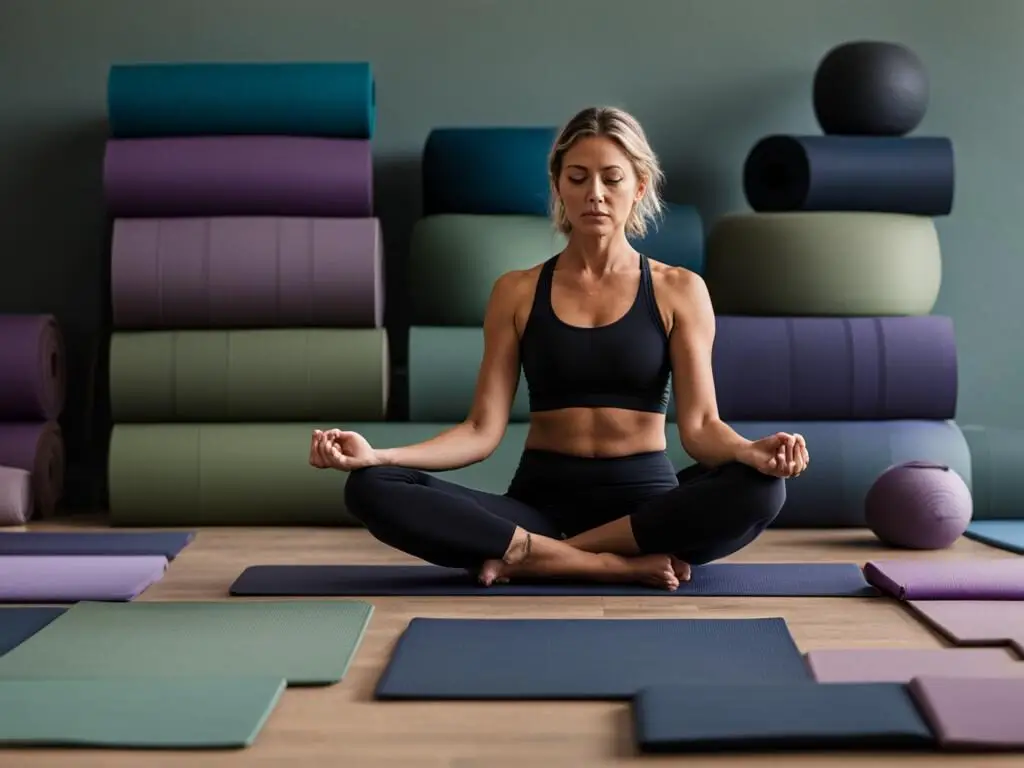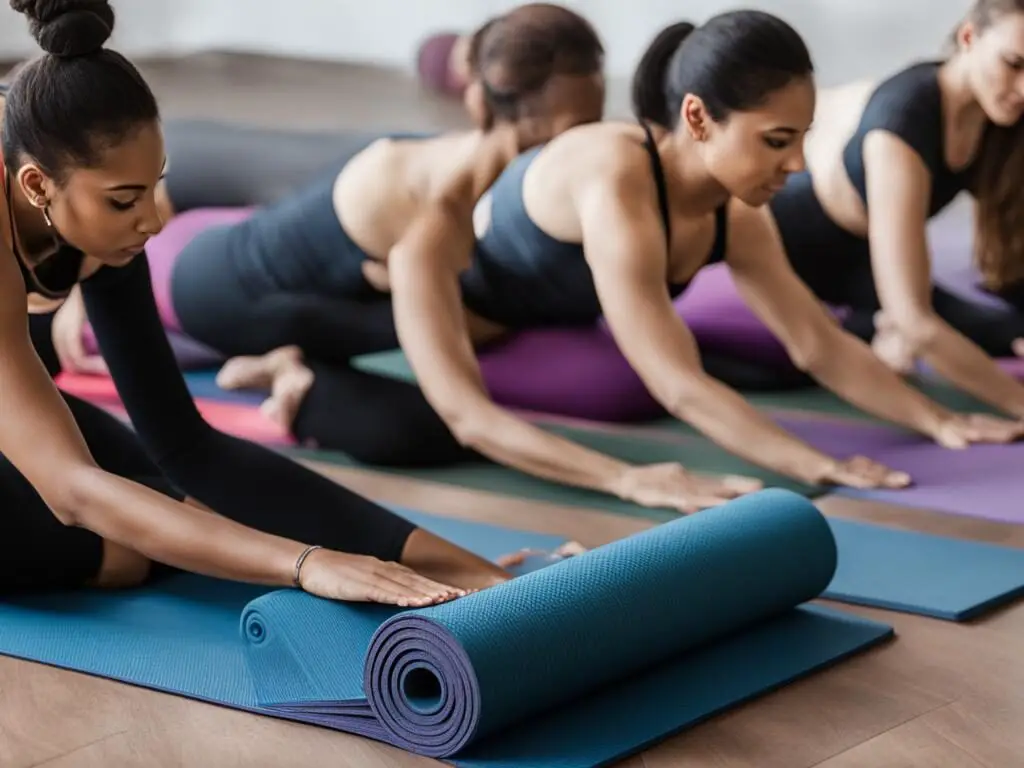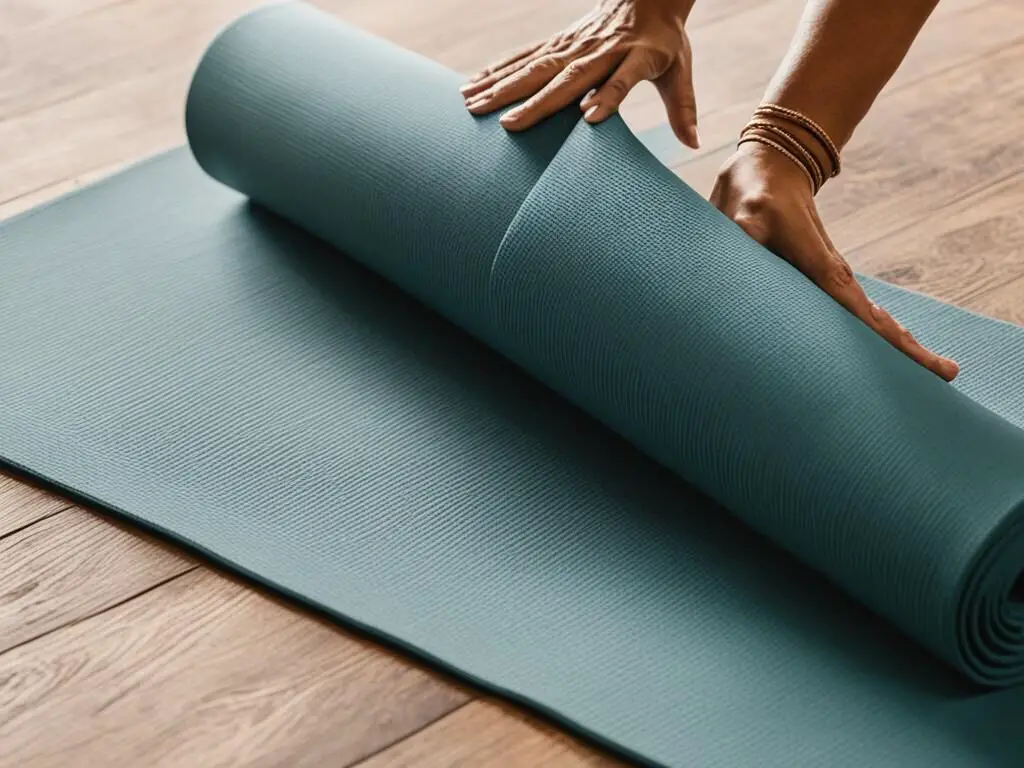Embarking on the quest to find the best yoga mat thickness has become quite the topic among wellness circles I mingle in. It’s fascinating how a simple slab of material becomes an ally in one’s yoga practice. Having experimented with various mat thicknesses, I’ve come to learn that there’s more science to it than what meets the eye. Deciding on the proper mat thickness is essential, not only for comfort but for the efficacy of your asanas.

As someone who’s navigated the world of yoga accessories for years, I’ve realized your choice can make or break your session. Whether you’re leaning towards a thick yoga mat for that extra joint support or an ultra-slim one for ease of transport, the decision isn’t to be taken lightly. I’m here to delve into what I discovered about mat thickness and how it influences the quality of your stretches and poses.
As we look closer into what makes an ideal yoga mat, it’s evident that issues like knee pain or lack of stability all trace back to the thickness of your mat. Let’s take the journey together to choose the best yoga mat for your personal use. After all, your mat is a sanctuary where your body and mind unite, and it ought to be nothing short of perfect. And remember, opting for the best mat for yoga isn’t just about the price tag or brand; it’s about how those few millimeters align with your body’s needs.
Key Takeaways
- Finding the right amount of cushioning can prevent joint discomfort.
- The ideal mat thickness enhances both comfort and performance during yoga.
- Material quality and eco-friendliness are as crucial as the mat’s thickness.
- Balancing thickness and stability is key for a fulfilling yoga experience.
- A personal assessment of one’s practice style is imperative in selecting mat thickness.
- An optimal yoga mat serves as a foundation for both physical and mental connection.
Understanding Yoga Mat Thickness and Your Practice
As I explore the importance of a yoga mat in enhancing my yoga experience, I realize that the thickness of a yoga mat plays a critical role in joint protection and comfort. It’s not just about aesthetics; the right thickness is vital for a safe and effective practice across the different types of yoga. In this section, we’ll examine how the thickness and mat material intertwine to influence your choice of a yoga mat.
Why Thickness Matters for Joint Protection
When I’m holding yoga poses that exert pressure on my wrists and knees, a properly cushioned surface is key to avoiding discomfort or injury. It’s clear to me that not every yoga mat is created equal when it comes to safeguarding my joints. Let’s delve into the importance of selecting a mat with an optimal level of thickness for joint protection.
Navigating Different Types of Yoga Mat Thicknesses
By exploring different yoga mat thicknesses, I’ve discovered that they cater to unique needs and preferences. Whether you’re often on the go with travel mats or prefer the extra support of thicker mats, each thickness addresses a particular aspect of your yoga practice.
How Mat Material Affects Thickness
Choosing a material for a yoga mat isn’t just about texture; it directly impacts the mat’s thickness and functionality. Natural mat materials like rubber and cork strike a balance, offering enough support without compromising on stability.
Here’s a breakdown of how to choose a yoga mat based on the materials available:
| Material | Thickness(mm) | Joint Protection | Balance Control | Eco-Friendliness |
|---|---|---|---|---|
| PVC | Varies | Good | Excellent | Low |
| Foam | Medium to Thick | Very Good | Good | Low to Medium |
| Rubber | Medium | Excellent | Very Good | High |
| Jute | Thin to Medium | Average | Good | High |
| Organic Cotton | Thick | Excellent | Average | Very High |
In summary, while browsing through yoga mat options, I always consider the trade-off between cushioning and stability. My aim is to find a mat that offers the right level of protection without hindering my balance or performance in various yoga routines.
Finding the Sweet Spot: Balancing Support and Stability
As someone who integrates daily yoga practice into my life, I’ve come to appreciate that the key to a satisfactory session lies in locating the perfect equilibrium between comfort and a firm foundation. This intersection not only enhances the experience but is also vital for maintaining support and stability throughout a variety of specific yoga poses. Understanding the best yoga mat thickness for your routine can make a significant difference. Below, we’ll delve into details that might help you conclude what features define the ideal yoga mat thickness for your personal practice.
Comparing Ultra Thin to Ultra Thick Mats
I’ve realized that opulent, extra thick yoga mats are often revered by those who prioritize joint cushioning above all else, yet they can be counterproductive when attempting flowing sequences. Conversely, I’ve grappled with travel yoga mats – their sleek profile exemplifies portability, but frequent use reveals that they occasionally fall short on providing the requisite padding. I’ve found that a yoga mat comparison can be quite the eye-opener for those yet to decide on their mat of choice.
The Optimal Range for Most Practitioners
From my experience, the ideal yoga mat thickness gravitates towards a sweet spot of about 4-5mm. This measurement strikes a harmonious balance, adequately supporting the body for an array of dynamic exercises while still ensuring a strong tactile connection with the ground – critical for balance and precision in practice. This thickness seems to be in the yoga mat optimal range for beginners and seasoned practitioners alike, given the universal pursuit of a gratifying yoga journey.
Adjusting Mat Thickness for Specific Yoga Poses
While the aforementioned range is often suitable, there are moments in my practice, especially when engaging with specific yoga poses, that beckon for mat thickness adjustments. Delicate joints sometimes yearn for extra padding during peak poses, or when settling into a deep stretch means sustaining a pose. On those occasions, I’ll opt for a mat that’s a tad thicker without venturing into the realm of extra thick yoga mats which can disturb my stability during standing asanas.

Reviewing various mats has taught me that, similar to life, yoga demands a blend of suppleness and steadfastness. Below, I’ve condensated of this concept into a table, succinctly depicting how mat thickness influences certain aspects of the yoga you practice:
| Mat Thickness | Cushioning | Stability | Portability | Ideal Practice Type |
|---|---|---|---|---|
| 1-2mm (Travel Mat) | Minimal | High | Excellent | Flow, Travel |
| 4-5mm (Standard Range) | Moderate | Moderate | Good | General, Daily Yoga |
| 6mm and above (Thick Mat) | Maximum | Lower | Fair | Restorative, Therapeutic |
To summarize, my personal revelation through various trials and tribulations is that investing in one’s search for the best yoga mat thickness is not merely about acquisition but rather crafting a bridge to a superior practice. Consideration of your routine, preferred styles, and physical requirements will guide you in this endeavor. After all, yoga is a personal expedition, and the mat beneath your feet should be no less personal or instrumental in supporting your passage.
Travel Yoga Mats: The Thin, Portable Option
As someone constantly on the go, I’ve come to appreciate the travel yoga mat as an indispensable companion in my travel yoga practice. While traditional yoga mats can be bulky and difficult to carry, a portable yoga mat is the exact opposite—my experiences have led me to the conclusion that convenience does not have to compromise quality.
The typical travel mat is thin, averaging about 1-2 mm in thickness, which makes it exceptionally lightweight and space-saving. This slender design means that even the most space-conscious traveler can easily integrate a lightweight yoga mat into their journey. Despite their minimal cushioning, these mats pack a punch in terms of versatility and ease of use.
A unique feature I’ve frequently made use of is the foldable yoga mat option. This design element allows the mat to be compacted even further, reducing its footprint significantly—it’s a feature that frequent flyers and backpackers in particular will find invaluable. Furthermore, these mats are not just about being thin, they are constructed for easy transport, often coming with carrying straps or bags.
Here’s a quick comparison that highlights the essential features of a travel-friendly yoga mat:
| Feature | Description |
|---|---|
| Thickness | 1-2mm for maximum portability and storage efficiency |
| Weight | Made to be lightweight for hassle-free transportation |
| Portability | Often comes with handy straps or covers for easy carrying |
| Functionality | Can be laid over carpets or rental mats for additional comfort |
| Durability | Designed to resist wear and tear from frequent folding and travel |
| Material | Typically made from eco-friendly materials for a sustainable practice |
Whether it’s a quick asana session in a hotel room or a full practice in a remote nature retreat, the versatility and ease of a foldable yoga mat facilitate maintaining a consistent practice. For anyone looking for a travel yoga mat that meets the needs of an agile, on-the-move lifestyle, the above features should be a guideline in making the right choice.
Choosing the Best Yoga Mat Thickness for Your Style of Yoga
As I venture further into my yoga journey, I’ve realized that each style of yoga I explore has unique demands, particularly when it comes to the best yoga mat. Every twist, stretch, and hold is a personal experience, and the mat beneath me should be as responsive to my style of yoga as it is to the needs of my body.

Mats Suited for Dynamic and Hot Yoga
When the pace picks up in a dynamic yoga class, or the temperature soars in a hot yoga session, a dynamic yoga mat or a specialized hot yoga mat is my go-to. A mat thickness that straddles the line between cushion and stability is essential for these practices—usually around 4-5mm. This tailored mat thickness lets me seamlessly flow from pose to pose, providing enough support to safeguard my joints without compromising on the fluidity of my movements.
The Gentle Approach: Mats for Restorative and Yin Yoga
Sometimes, my practice requires me to slow down, encouraging deep relaxation and mindfulness in more meditative styles such as restorative and yin yoga. Here, a restorative yoga mat or a yin yoga mat with a thicker profile is my sanctuary. A mat is made comfortably will cradle my body for lengthy periods allows me to completely immerse myself in the gentle stretches and the stillness of my practice.
Personalizing Mat Thickness for Your Yoga Journey
Personalization in yoga extends to every element, and that includes my mat. I’ve found that a personalized yoga mat with a tailored mat thickness enriches my practice, catering not just to the type of yoga I’m passionate about but also to my physical needs at the moment. It’s not just about purchasing the best yoga mat; it’s about finding my best yoga mat—one that respects my preferences, supports my health, and aligns with my yoga journey.
| Yoga Style | Recommended Thickness | Cushioning Level | Stability Level |
|---|---|---|---|
| Dynamic/Hot Yoga | 4-5mm | Medium | High |
| Restorative/Yin Yoga | Thick (6mm or more) | High | Medium |
Eco-Friendly and Non-Toxic Options in Yoga Mat Thickness
As we delve deeper into our yoga practice, we inevitably confront the reality that every choice we make, from our poses to our props, has an environmental impact. That’s why I’ve shifted my focus towards sustainability, by investing in an eco-friendly yoga mat. Not only does a green yoga practice align with the yogic principles of honoring and respecting all living beings, but it also grants us peace of mind, knowing we’re not harming the planet.
When talking about eco yoga mat choices, a non-negotiable aspect for many of us is that they must be non-toxic. I have personally said goodbye to the conventional PVC yoga mats that are replete with chemicals and instead have embraced environmentally friendly yoga mat options.
The quest for an eco-friendly yoga mat that also meets our preferred thickness can sometimes be overwhelming. To simplify this, I’ve compiled a quick comparison of some popular, sustainable yoga mat materials and their respective thicknesses to help guide your purchase:
| Material | Typical Thickness | Advantages | Eco-friendliness |
|---|---|---|---|
| Natural Rubber | 3-5mm | Excellent grip, high durability | Biodegradable and renewable |
| Organic Cotton | 4-6mm | Soft, absorbent, washable | Fully biodegradable, pesticide-free farming |
| Jute | 4-5mm | Natural texture promotes grip, lightweight | Highly sustainable, biodegradable |
| Recycled Rubber | 3-6mm | Diverse thickness range, durable | Reduces landfill waste, often upcycled |
Committing to a PVC-free yoga mat not only supports your health but contributes to a wider environmental cause. Natural yoga mat options may appear as a higher upfront investment, but the durability and non-toxic nature of these materials ensure a longer lifespan and a practice that’s aligned with our eco-conscious values.
In choosing the right mat, consider how a sustainable yoga mat material aligns with both your personal practice and ecological philosophy. It’s a balance — much like the poses we perform — between our need for comfort and our commitment to the Earth.
How to Keep Your Mat in Great Shape Regardless of Thickness
As a dedicated yogi, I’ve learned that maintaining your yoga mat is not just about cleanliness; it’s about preserving the essence of your practice. The way we caring for our yoga mats can significantly impact their yoga mat longevity. Through my experience, I’ve picked up several mat care tips that aid in prolonging yoga mat life, and I’m eager to share them with you.
Firstly, it’s essential to keep your mat clean not only for hygiene but to maintain its non-slip surface. A simple yet effective cleaning your yoga mat routine after each session can do wonders. For most mats, a soft cloth dampened with water and a mild detergent works well, but care should be taken for mats made of more sensitive materials.
Remember, the better we care for our yoga tools, the more they give back to our practice.
- After each use, wipe down your mat with a cloth and a natural spray cleaner specially formulated for yoga mats.
- Allow it to air dry completely before rolling up to prevent mold and mildew.
- Deep clean your mat with a gentle wash every few months, depending on the frequency of use.
- Store your mat in a cool, dry place out of direct sunlight to maintain its integrity.
A bit more attention is necessary when we talk about eco-friendly mats, like those made from natural rubber or organic cotton. These materials naturally break down over time, but using environmentally responsible cleaners can help prolong the life of your mat while keeping in line with sustainable practices.
| Mat Material | Cleaning Method | Frequency |
|---|---|---|
| PVC | Water mixed with mild detergent | After every use |
| Natural Rubber | Eco-friendly cleaner or homemade solution (water and essential oils) | 1-2 times a week |
| Organic Cotton | Cold water hand wash with mild detergent | Monthly |
| Jute | Damp cloth without oils or soaps | As needed |
It’s invigorating to practice on a mat that’s well-cared-for, and knowing you’re maintaining your yoga mat effectively amplifies the satisfaction. Carve out a few minutes after your practice for mat care—your future self will thank you for the added years to your mat’s life.

Conclusion
As we wrap up, I can’t overstate the importance of finding the right yoga mat thickness that harmonizes with your practice. A mat that’s too thin might leave you craving cushioning, whereas one that’s overly thick could disrupt your balance and flow. It’s apparent that the mat thickness conclusion for many is that the middle ground, typically ranging from 4-5mm, offers the ideal fusion of comfort and stability, setting the stage for a flourishing yoga experience. It’s been an enlightening journey to understand that making the right yoga mat investment is less about finding a one-size-fits-all solution and more about discovering what uniquely works for you, your body, and your style of yoga.
Moreover, the composition of the mat itself demands attention. In my quest to choose the right yoga mat, I’ve grown increasingly mindful of the materials and their impact on our planet. Steering away from non-sustainable materials like PVC not only aligns with my eco-friendly values but also ensures that my practice reinforces my commitment to environmental stewardship. Whether you’re just starting your yoga path or you’re a yoga instructor guiding others, the best yoga mat choice is one that resonates with your personal ethos and enhances the sacred space of your practice.
In sum, my final thoughts on yoga mat thickness underscore that it’s more than just picking out a mat—it’s about making a benign choice that supports your journey in every pose and breath. Remember, your mat is a partner in your yoga voyage, and choosing wisely is integral to nurturing your practice’s growth and sustainability. If health concerns are a part of your decision matrix, I encourage you to consult a healthcare provider or yoga professional to tailor your choice to your specific needs. Here’s to a grounded, cushioned, and conscientious practice ahead.
FAQ
What is the ideal yoga mat thickness?
The ideal yoga mat thickness often ranges between 4-5mm. This provides a balance of cushioning for joint protection and stability for poses, suitable for a wide range of yoga practices.
Does the type of yoga I practice affect the thickness of mat I should choose?
Absolutely. If you’re into dynamic styles or hot yoga, a medium thickness mat (4-5mm) is typically preferred. For gentler, restorative, or yin yoga, a thicker mat might be more comfortable to protect your joints during longer-held poses.
Are thicker yoga mats always more comfortable?
Not necessarily. While thicker mats provide more cushioning, they can sometimes be too soft, affecting your balance and stability during practice. It’s all about finding the right balance that suits your body and practice.
Is a travel yoga mat worth it?
If you’re frequently on the move and want to maintain your practice, a travel yoga mat can be an incredible investment. They’re lightweight and easy to carry, just keep in mind that they are thinner and provide less cushioning.
Why should I consider the material of a yoga mat?
The mat material can affect the grip, durability, cushioning, and environmental footprint. Natural materials like rubber or cork are eco-friendlier and may offer a better balance of comfort and stability than synthetic ones like PVC.
How do I maintain my yoga mat, and does thickness play a role?
Mat maintenance is essential regardless of thickness. You should clean your mat regularly to preserve its grip and prolong its lifespan. Thicker mats may require more frequent cleaning as they can harbor more sweat and bacteria.
Can the thickness of my yoga mat impact my joint health?
Definitely. A mat that’s too thin may not offer adequate protection, leading to joint pain. However, a mat that’s too thick can lack proper support, potentially leading to misalignment and discomfort.
Are eco-friendly yoga mats available in different thicknesses?
Yes, eco-friendly yoga mats come in various thicknesses to cater to different preferences and practices, allowing you to choose a sustainable option without compromising on comfort or performance.
How can I adjust my mat thickness for specific yoga poses?
If your mat isn’t thick enough for certain poses, you can use yoga props like folded blankets or an additional mat for extra padding. Conversely, if your mat is too thick, you may choose to perform standing poses on the floor for more stability.